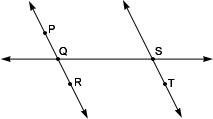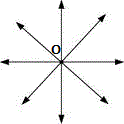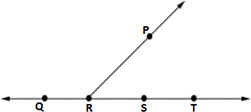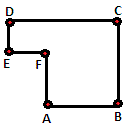Solved Examples and Worksheet for Points, Rays, Angles, Lines and Line Segments

A. 13 units and 7 units
B. 16 units and 4 units
C. 14 units and 6 units
D. 15 units and 5 units
Step: 1
The length of PQ = 20 units.
Step: 2
PR = (3 4
Step: 3
PR = (3 4
Step: 4
RQ = PQ - PR = 20 - 15 = 5
[Substitute PQ = 20 and PR = 15]
Step: 5
PR = 15 units and RQ = 5 units.
Correct Answer is : 15 units and 5 units
Step: 1
A ray is a part of a line. It has one end point and any number of points on one side of the end point.
Step: 2
A ray is named by the end point and any other point on the ray.
Step: 3
The rays in the figure, with Q as the end point are QP → QR → QS →
Step: 4
The rays in the figure, with P as the end point are PQ → PR →
Step: 5
The rays in the figure, with R as the end point are RQ → RP →
Step: 6
The rays in the figure, with S as the end point are SQ → ST →
Step: 7
The ray in the figure, with T as the end point is TS →
Step: 8
So, the total number of rays in the figure is 10.
[3 + 2 + 2 + 2 + 1 = 10.]
Correct Answer is : 10
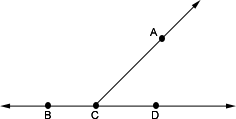
A.
B.
C.
D.
Step: 1
'If the points lie on the same line, then the points are called collinear points.'
Step: 2
From the figure, B C D
Step: 3
So, B C D
Correct Answer is : B C D
A. 5
B. 10
C. infinite
D. 20
Step: 1
Let P, Q, R, S and T be the five non-collinear points.
Step: 2
Join PQ ¯ QR ¯ RS ¯ ST ¯ TP ¯ PR ¯ PS ¯ QT ¯ QS ¯ RT ¯


Step: 3
So, the number of segments that can be drawn using five non-collinear points is 10.
Correct Answer is : 10
Step: 1
A line segment is a part of a line. It is made up of two points and all the points of the line that joins the two points.
Step: 2
In the figure, PQ ¯ QR ¯ RS ¯ PR ¯ QS ¯ PS ¯
Step: 3
So, the number of line segments in the figure is 6.
Correct Answer is : 6
A. 36
B. 30
C. 15
D. 18
Step: 1
Let A, B, C, D, E and F be the six non-collinear points.
Step: 2
Join AB ¯ BC ¯ CD ¯ DE ¯ EF ¯ FA ¯ AC ¯ AD ¯ AE ¯ BD ¯ BE ¯ BF ¯ CE ¯ CF ¯ DF ¯
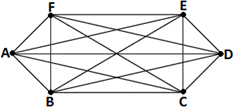

Step: 3
So, the number of segments that can be drawn using six non-collinear points is 15.
Correct Answer is : 15
Step: 1
A line segment is a part of a line having exactly two end points.
Step: 2
The line segments in the figure are PR ¯ QR ¯ RS ¯ ST ¯ QS ¯ RT ¯ QT ¯
[Identify the parts of line with exactly two end points.]
Step: 3
So, there are 7 segments in the figure.
Correct Answer is : 7
Step: 1
A line segment is a line or part of a line having exactly two end points.
Step: 2
The line segments in the figure are AB, BC, CD, DE, EF, and FA.
Step: 3
Therefore, there are 6 line segments in the given figure.
Correct Answer is : 6
- Parallel Lines and Transversals-Geometry-Solved Examples
- Angle Sum Theorem and Medians in a Triangle-Geometry-Solved Examples
- Properties of Isosceles Triangles-Geometry-Solved Examples
- Proving Quadrilateral is a Parallelogram-Geometry-Solved Examples
- ASA and AAS Postulates -Triangle Congruence-Geometry-Solved Examples
- SSS and SAS Postulates-Triangle Congruence-Geometry-Solved Examples
- Transformations-Reflections-Geometry-Solved Examples
- Transformations-Rotations-Geometry-Solved Examples
- Transformations-Translations-Geometry-Solved Examples
Related Worksheet
- Angle
- Line
- Line Segment
- Plane
- Ray
